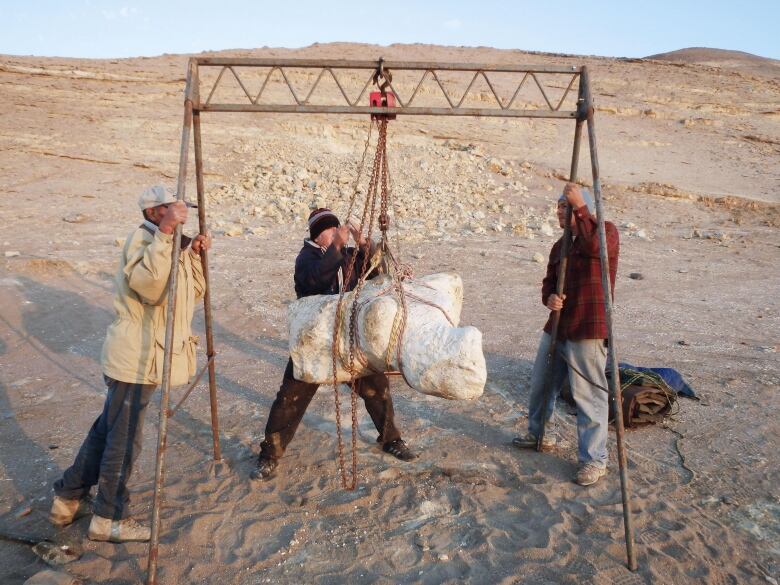The ‘chonkiest’ animal ever may have been this massive ancient whale

The bizarre bones of an ancient whale suggest it may have been the most massive animal that ever lived — outweighing the official record holder, today’s blue whale.
Researchers estimate that Perucetus colossus was about 20 metres long — about the length of an articulated bus, but shorter than the blue whale’s 24- to 30-metre length. But because of its unusual anatomy, including extremely dense bones, P. colossus had a mass of between 85 and 340 tonnes. That means it likely outweighed the blue whale, with an average mass of about 90 to 130 tonnes.
“The estimated skeletal mass of P. colossus exceeds that of any known mammal or aquatic vertebrate,” says a new study by an international team of scientists, led by Giovanni Bianucci of the University of Pisa, published Wednesday in Nature.
It’s a surprise in a number of ways, experts note, as whales were thought to evolve their large size later, and no modern whales show the strange adaptations that this ancient whale did.
An artist’s reconstruction of the creature shows a huge, rotund whale-like animal with tiny hind limbs sticking out, short webbed front paws and a flat, small, pointed snout and a rounded tail fluke. Researchers say the whale lived 39 million years ago, during the Eocene epoch, in coastal waters in what is now Peru.
Eli Amson, curator of fossil mammals at the State Museum of Natural History in Stuttgart, Germany, and co-author of the paper, acknowledges, “It must have been a really weird-looking animal.”
In fact, he said, the drawing is quite conservative in its depiction of the animal. “The truth is, it probably was something even weirder, but difficult for us to picture.”
How the fossil was discovered
Peruvian paleontologists led by Mario Urbina of the Natural History Museum at the University of San Marcos in Lima were working in the Atacama Desert in southern Peru when they first spotted something strange sticking out of the sand about 13 years ago, Amson said.
At first, it was so odd that they weren’t sure if it was a rock or bone, so they did a chemical analysis on a small sample. Sure enough, it was a fossil bone, so they started excavating. Over a decade, they uncovered 13 massive vertebrae, each over 100 kilograms; four ribs, each up to 1.4 metres long; and a small hip bone.

Based on the age and size of the fossils, they knew it had to belong to a family of ancient whales called basilosaurids. But the vertebra looked like those of no other animal — Amson described them as “crazily inflated” with so much extra bone on the outside of it that it was no longer really identifiable. Fortunately, the small hip bone was found and is very characteristic of this group of whales.
Why the whale was so heavy
While there weren’t a lot of other fossils with the whale, fragments of fish scales and pieces of wood suggested it was a coastal environment, though the thin sediments showed it was some distance from the shore.
At the time, Amson said, the Earth was warmer and coastal areas contained far more food than they do now, potentially allowing them to support larger animals. But the climate was also cooling, forcing animals to adapt.
The researchers think it’s this combination that led to the whale’s bizarre anatomy.

Similar densification of bones is seen in animals that do shallow diving in coastal areas, such as manatees and dugongs. Amson likens it to the lead belt that scuba divers wear to counteract the buoyancy of their other diving equipment — something that modern whales don’t need because they dive so deep that their lungs collapse, reducing their buoyancy.
On the other hand, the extinct Steller’s sea cow, a shallow diver that lived in colder waters than its manatee relatives, developed extremely dense bones to compensate for huge amounts of blubber.
The researchers think P. colossus had a similar adaptation to the cooling climate.
What this tells us about how whales got huge
Paleontologists who weren’t involved in the study said they were astonished by the sight of the bones and the apparent size of the animal.
Travis Park is a postdoctoral researcher at the Natural History Museum in London who co-authored a study earlier this year on how whale sizes changed over time. He and his colleagues suggested that extreme body size only evolved in whales during the last 5 million to 7 million years.
He said the new discovery that something the size of a blue whale lived 30 million years before that is “a real shock.”

“I was blown away by the images of the actual vertebrae themselves,” he added, describing them as looking like they had been blown up with an air pump. “It would be have been quite an amazing animal to see.”
Nick Pyenson, curator of marine mammal fossils at the Smithsonian Institution in Washington, D.C., noted that P. colossus lived at the time of the first fully aquatic whales. He called its proposed dimensions “truly stupendous.”
He added that the new discovery confirms what the previous discovery of 20-metre-long Basilosaurus from the same time period suggested — that it didn’t take whales tens of millions of years to evolve a very large body size. “They did so rather rapidly.”
Victoria Arbour, curator of paleontology at the Royal BC Museum, has been studying a possible basilosaurid whale vertebra found on the B.C. coast.
She called P. colossus a “really bizarre and intriguing discovery” that points to “some interesting evolutionary experiments in different lifestyles for the earliest whales.”
But was P. colossus really heavier than a blue whale?
Park, Pysenson and Arbour all agreed that P. colossus was clearly huge. But was it really heavier than a blue whale?
All of them said it’s hard to say without more of the whale’s skeleton. In particular, all noted that the head and teeth are missing — parts of the animal that might offer some insights about what it ate to grow to such an enormous size.
Arbour said given the limitations, “I don’t think the suggestion that this animal could be close to, or even a bit heavier than, a blue whale is out of line, although it will need to be tested with more complete specimens.”
Park said P. colossus certainly could be in or around the size of a blue whale, but he wasn’t sure it was biologically feasible to get much bigger than that.
Pyenson said he’d put his money on the animal being “likely not” bigger than a blue whale.
“Some of the chonkiest interpretations of Perucetus are likely not right,” he said, “and it will just take a lot more work to find more of a complete skeleton of this amazingly large early whale to know.”
The new study was funded by the Palaeontological Association, University of Pisa, University of Camerino and the Italian Ministero dell’Istruzione dell’Università e della Ricerca.
To help with future discoveries in the Atacama Desert, Urbino has launched a crowdfunding campaign to build a fossil preparation lab in Peru.




